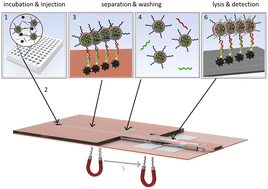Miniaturized sensor for electroanalytical and electrochemiluminescent detection of pathogens enabled through laser-induced graphene electrodes embedded in microfluidic channels†
Abstract
High performance, laser-induced graphene (LIG) electrodes were integrated into adhesive tape-based microfluidic channels to realize both electrochemical (EC) and electrochemiluminescent (ECL) detection approaches. This provides strategies for low limits of detection, simple hardware requirements and inexpensive fabrication, which are characteristics required for assays in the competitive point-of-care (POC) sensor field. Here, electrode design and microchannel dimensions were studied and a DNA hybridization assay with liposomes for signal amplification was developed for the specific detection of DNA derived from Cryptosporidium parvum as the model analyte. Liposomes entrapped either Ru(bpy)32+ or K4[Fe(CN)6] generating ECL- and EC-signal amplification, respectively. This new microchip provided all desirable analytical figures of merit needed for POC applications. Specifically, a desirable one-step assay was designed which provided a limit of detection of 3 pmol L−1 for the ECL and 47 pmol L−1 for the EC approach and furthermore enabled highly specific detection considering that at room temperature in this simple setup a single nucleotide polymorphism resulted in a signal decrease of 58%, whereas a decrease of > 98% was observed for non-matching sequences present in 10-fold excess. Direct detection in various matrices ranging from drinking water to soil extracts was also achieved. It is concluded that the simple and inexpensive fabrication in combination with signal amplification strategies makes these concepts relevant for on-site pathogen detection in resource-limited environments.

- This article is part of the themed collection: Miniaturised Sensors & Diagnostics


 Please wait while we load your content...
Please wait while we load your content...